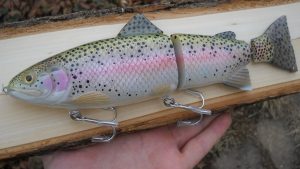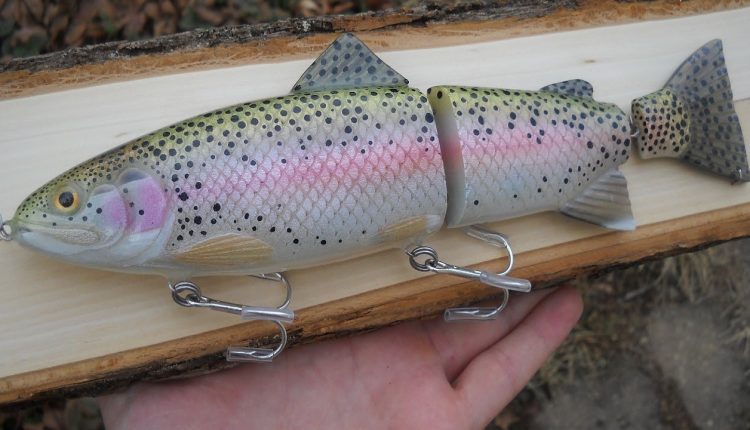Fishing for Trout with Swimbaits
A swimbait is a lure that acts as a though it is a live fish as the lure is reeled in. Many swim baits may features spinners, long tails, or other modifications that may increase the odds of a target fish noticing the lure. A swimbait is usually made from a soft plastic, although also is designed with sections of wood and/or hard plastic.

A swimbait will fall into one of the following categories, and should be fished accordingly.
Hard body swimbait –
- Non jointed hard body swimbaits, that are effective for trout fishing, usually features a feather or some type of attractant near the tail. This type of swimbait seems to perform best in top water, or shallow locations.
- Jointed hard body swimbaits can be effective in various water depths. Jointed hard body swimbaits are often built to mimic the shape and movement of a wounded fish.

Soft body swimbait –
- There are dozens of types of soft swimbaits, various styles and lengths… from worms, small fish, to critter types. Soft body swimbaits have offered some of the most consistent trout fishing for me. My personal favorite has been a small “rainbow trout” looking swim bait approximately 3-4 inches in length.
Soft hollow body swimbait –
- Hollow swimbaits feature the ability for your lure to vibrate, or move, and a much faster pace and many times will attract trout from a further distance than a traditional swim bait would.
- Soft hollow body swimbaits are just as effective as soft body swim baits that are not hollow.
- Soft hoing watllow body swimbaits are best utilized in faster moving waters.
- The main drawback in using soft hollow body swimbaits is that the lure can be destroyed by your first strike from a large fish.
Now that we have broken down some of the differences in swimbaits, lets look at some of the basic rules when fishing with any one of the types of the swimbaits.
- During the warmer months trout are more active, and are more likely to strike a fast moving swimbait… while many times in the colder months trout are more likely to strike a swimbait only if it is drawn incredibly close to them and in a natural fashion.
- Always cast into the wind, and retrieve with the current. Throughout the year trout sit facing the current waiting for food to be brought to them.
- Fish during the sunrise and sunset. During these times many fish, including trout, are known to “graze”. This grazing will bring the trout into incredibly shallow waters (1-4 feet deep) and close to shore. This is a great time to step into the water, or find a point of land, cast and retrieve parallel with the shore, with the current.
Fishing with swimbaits, especially when fishing for trout, has been the most effective methods for me, personally… and I have heard the same from many other fishermen. Fishing with swimbaits is a style of trout fishing that you will need to get comfortable with before you are consistently effective, determining the speed to retrieve the swim bait is of the up most importance, and is a case by case basis that can be best understood simply by trying the swimbait out, as a general rule of thumb retrieve fast enough to get full action from the swimbait but not fast enough that the swim bait breaks water.
Good luck, and as always please release any fish that you do not plan on eating.

